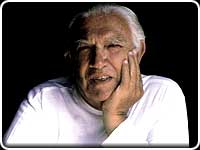|

As
as 1952 the author of the Mass for the Nyondo Mission, where the theme of the
“Tropics” as orientation for inspiration was limited to the
“Atmosphere” of the landscape and the spiritual influence from
Inner Africa, the composer, Alberto Bruni Tedeschi, returns in this work to a
si-milar theme in another biographical order and straight through the midst of
impressions which are awakened by the description of experiences and conveyed
by the “carnets de voyage”, adven-tures in Guyana by Raymond
Maufrais. These “Carnets” document the last journey of Maufrais,
the daring explorer, who disappeared in Guyana; and the countless expeditions,
which were orga-nised by his father (who lives in Toulon), have failed to show
a trace of him.
“Exploration
is for me an adventure of purity and humility”. These words of Maufrais
were placed by Bruni Tedeschi on the title page of the score. To the title,
“Journey and End”, is added the subtitle, “Tropical Cantata
for tenor and orchestra”, text by Giampiero Bona.
Inspired
by Maufrais's adventures in Guyana, the text by Bona is grouped in II fragments
and short chapters which let the narrative material arise in
“hymns” and lyrical situations with such tone, bars, liveliness and
quickness of the images as in an almost epic popular ballad: the depar-ture;
the rain (the expectation); the rain (approaching march); the mosquitos
(approaching march); the ghosts (the night); camp I (the night); camp Il
(hunger and thirst); camp III (the storm); the connection; the last hunger; the
disappearance.
On
the musical level, the dense formulation of the instrumental part and the
entirety of the sym-phonic score grant the work the very character and
magnificence which one would require to declare it a “concert for
orchestra”, but it is, however, a concert without division into genuine
independent movements, since the tenor voice (with the poetic word which this
brings with it and the expressive tension presented by the rather varying play
of syllables largely immerse in his movements) introduces a dominating role to
the action in the course of the musical portrayal in the form of the changing
of his gestures, which conjures and strongly veils the instrumentation rich in
sound colouration and emphasized by percussion instruments, donned with a
general “foreign” colouration, that was intended by the personal
vision of the composer.
The
work begins with an orchestral overture titled “The Sea”. In slow
rhythmic succession a con-tinuous rhythmic fluctuation between a deep pleasant
sound at first then developing into more complex forms then vanishing in the
colouration and melodic lines, which are raised by the flute, the saxophone and
a solo violin, while the harp produces wave-like chords, and an ever
increa-sing tension leads ultimately to the tenor's commencement in the first
part of the Journey: the de-parture, Antilles green sea/green Guyanan
evening/dancing and crying/on board the Guascogna...
The
action of the various hymns in subsequent parts of the “Journey”
culminates in the excite-ment of the conjuring allegro agitato in Camp III (the
storm): “As a huge buffalo walking/the thunder over the Uagi
Swamp/Heaven's bowels are bursting/the mist is rising from the Majouri”.
After this is the “End”, beginning with “The
Connection”, feverishly torn accents of the deep instruments underlining
the tenor's song “almost spoken” (“Walking on knees/on the
trail of the deadly anaconda”), and the climaxes of dramatie excitement
of the penetrating sounds of the tenor's voice and the stormy movement of the
orchestra, engulfing the last words: “Forwards, ever forwards/Hours,
days, death, endlessness”, and then it stops subbornly with a serious and
pitiful tone in the deepest part of the orchestra with two tones near each
other alternating, then falling off with dissipating strength to the
disappearance, in which the musical and poetic alternation come to a close.
|




|
